ЯЛИНОВА ШИШКА ніж ручної роботи майстра студії Павла Гончаренка, Ламінат зі сталі CPM10V 64 HRC
- Виробник: Майстерня ножів ручної роботи Павла Гончаренка
- Модель: ЯЛИНОВА ШИШКА - студія ножів ручної роботи Павла Гончаренк
| Загальна довжина клинка mm: | 275±05 мм |
| Матеріал леза | Клинок - Ламінат зі сталі CPM10V в нержавійці 95х18, американська порошкова сталь від компанії Crucible |
| Твердість клинка (метал): | Загартованість - 64 HRC |
| Матеріал руків'я: | Карбон, ріг азіатського буйвола, нержавійка, g10, стабілізована шишка в акрилі, мозаїчна темлячна трубка. Темляк зі шкіряного шнура 3 мм. Бусини з гібриду зі стабілізованої шишки і акрилу |
| Довжина леза | 140±05 мм |
- Наявність: Під замовлення
Опис
ТЕХНІЧНІ ХАРАКТЕРИСТИКИ:
Назва ножа - ЯЛИНОВА ШИШКА ексклюзивний ніж ручної роботи майстра студії Павла Гончаренка, замовити купити в Україні (Сталь - Ламінат зі сталі CPM10V в нержавійці 95х18)
Тип ножа: Фіксований клинок
Бренд: Студія "Ножі ручної роботи Павла Гончаренка"
Сталевий лист: Ціліснолитий, наскрізний монтаж на стяжку та епоксидну смолу.
Заточення леза: Загострений на 36 градусів
Твердість леза: 64 HRC
Загальна довжина: 275 мм
Довжина леза: 140 мм
Ширина леза: 31 мм
Товщина леза: 3,8 мм
Довжина руків'я: 135 мм
Товщина руків'я: 31 мм
Руків'я: Карбон, ріг азіатського буйвола, нержавійка, g10, стабілізована шишка в акрилі, мозаїчна темлячна трубка. Темляк зі шкіряного шнура 3 мм. Бусини з гібриду зі стабілізованої шишки і акрилу
Колір руків'я: Темно-коричневий
Просочення руків'я: Є
Покриття руків'я: Є
Отвір для шнурка (під темляк): Є
Темляк: Темляк зі шкіряного шнура 3мм, бусини з гібриду і капа клену.
Піхви: Горіх тонований, італійська натуральна теляча шкіра чепрак рослинного дублення, оброблена апретурою для захисту від води та просякнута захисними розчинами, прошита вручну вощеною ниткою. Ручне різьблення по дереву та художня розфарбовка, деревяна вставка в середині. Підвіс з'ємний, вставка з стабілізованої шишки і акрилу.
Модель: ЯЛИНОВА ШИШКА ексклюзивний ніж ручної роботи майстра студії Павла Гончаренка, замовити купити в Україні (Ламінат зі сталі CPM10V в нержавійці 95х18)
Номер моделі: 074
Країна народження: Україна
Ремісник: Майстер Павло Гончаренко, м. Іванків, Україна ("Ножі ручної роботи Павла Гончаренка")
Найкраще використання: Полювання, поділ тушки, нарізка
Стан ножа: новий
Ціна вказана разом з піхвами.
Заточений ніж - не є холодною зброєю.
Наші ножі дуже гострі, тому відкривайте та використовуйте їх дуже обережно. Ми не несемо відповідальності за будь-які травми, пов’язані з використанням наших ножів.
Наша продукція призначена для легального використання лише відповідальними покупцями. Ми не будемо продавати наші продукти особам молодше 18 років.
Наявність регулярно змінюється, при підтвердженні Вашого замовлення ми повідомимо про наявність або термін готовності товару. Виріб може трохи відрізнятися від представленого на фото.
| Визначення |
|---|
|
CPM-10V CPM-10V - американська порошкова сталь від компанії Crucible. CPM-10V є сплавом з високою масовою часткою ванадію і вуглецю у складі. Для марки CPM-10V характерна підвищена стійкість до зношування, але дуже скромна стійкість до ударних навантажень. Відомо, що в рамках тестових випробувань ніж зі сталі CPM-10V успішно розрізав 999 разів канат з пеньки, зберігши свої можливості, в той час як ніж зі сталі YXR обмежився 250 різами. З урахуванням того, що сталь даної марки важко піддається шліфування, у великосерійному ножовому виробництві практично не використовується. В основному можна купити ніж зі сталі CPM-10V у кастомному виконанні . Зі слабких місць можна виділити невисоку стійкість до корозійного впливу.
В основі технології виробництва лежить методика CPM (аморфні сплави), що знайшло відображення в назві сталі. На тлі традиційних сталей дана технологія забезпечує граничний рівень структурної однорідності та жорсткості металу.
|
Деревина горіха має гарні фізико-механічні властивості
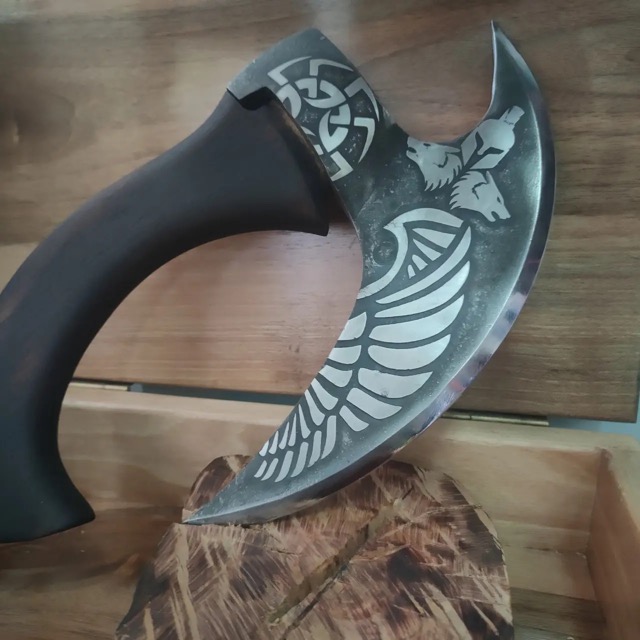
Деревина горіха має гарні фізико-механічні властивості – вона досить щільна та міцна, легко піддається обробці як верстатними, так і ручними інструментами. Надійність, а також висока декоративність та пристосованість до різних зовнішніх умов зробили горіх популярним столярним матеріалом не тільки на континенті, але і по всьому світу. Американський горіх повсюдно використовується для створення практично будь-яких виробів з дерева, що відрізняються і естетичності, і довговічністю.
Деревина горіха має темне забарвлення у шоколадно-коричневих тонах, іноді з легким фіолетовим відтінком. Його благородна текстура високо цінується під час створення виробів ручної роботи. Якісне шліфування та безбарвне фінішне покриття ще сильніше підкреслюють виразний малюнок та колір деревини.
Обробка американського горіха зазвичай не приносить складнощів. Він добре ріжеться і стругає гострим інструментом, чудово шліфується і полірується до блиску. Непогано тримає дрібні деталі – вироби з горіха можна покривати тонким художнім різьбленням. Для захисного просочення чорного горіха підходить будь-який засіб для дерева. Тонувати і фарбувати його не прийнято, тому що в деревині цінується натуральна колірна гама.
Американський горіх досить міцний, в'язкий і важкий для того, щоб використовувати його для сокир. Його зносостійкість дозволяє створювати сокири для активного використання у несприятливих погодних умовах. Тим не менш, американський горіх не згодиться за міцністю для виготовлення колуна з довгим вузьким сокирою або важким молотом. Для невеликих робочих знарядь та колекційних виробів він підходить ідеально.
Приклади виробів із деревини американського горіха
Благородні кольори та виразна текстура горіха чудово прикрасять колекційні сокири ручної роботи:
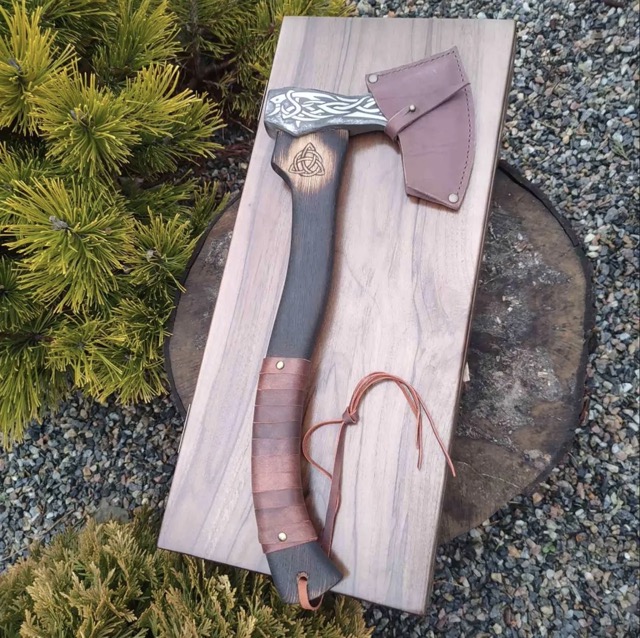
Американський горіх добре підійде для створення сокир невеликих робочих сокир:
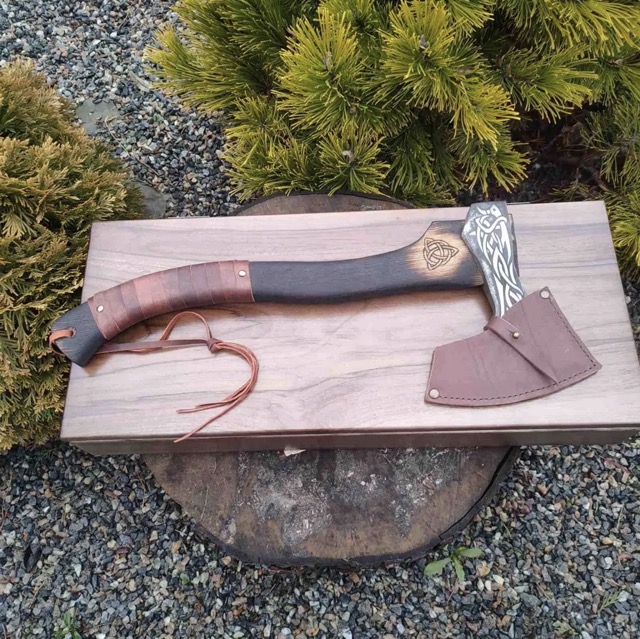
Звичайно, формат заготовок підходить не тільки для виготовлення сокир. Наприклад, з бруска можна виготовити флейту, до того ж американський горіх має відмінні акустичні характеристики:
Інтернет-магазин Knife.net.ua пропонує ножі ручної роботи, ексклюзивні ножі на замовлення для вибагливих чоловіків та мисливців, вироблені руками найкращих майстрів України для використання на полюванні, в нестандартних ситуаціях за вигідною ціною на замовлення або на вибір в нашому магазині. Якісний інструмент для індивідуального використання в польових умовах або на полюванні. Доставка здійснюється по всій Україні протягом кількох днів. Knife.net.ua – найкращий вибір ножів в Україні від майстрів ручної роботи..
КАРБОН - РУКОЯТКИ НОЖІВ З ЦЬОГО ПРЕМІАЛЬНОГО МАТЕРІАЛУ
Одним з найпрестижніших і дорогих матеріалів для рукояток ножів крім титану і дорогих порід деревини є різновид вуглепластика, так званий «карбон». Матеріал цінується за виняткову легкість, міцність та естетичну красу.
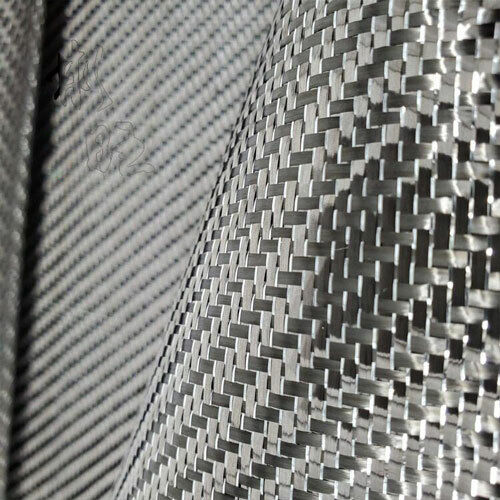
Карбон (від англ. carbon - вуглець) - це полімерний матеріал з композитним складом, виготовлений з переплетених ниток вуглецевого волокна (сarbon fibers). Ці нитки виготовляються з використанням епоксидних смол. Середня щільність матеріалу від 1450 кг/м³ до 2000 кг/м³. Головною відмінністю карбону від інших полімерів, що застосовуються при виготовленні ножів, є дуже невелика вага. Саме вага разом із винятковою міцністю дає карбону перевагу перед іншими матеріалами рукояток: полімером G10, мікартою, пластиком FRN і т.д. При цьому за питомими характеристиками міцності карбон перевершує конструкційні сталі. Основними якостями карбону є висока міцність на розрив, стійкість до високих температур, агресивних середовищ, незначне розширення при нагріванні, висока електропровідність. Також важливою рисою карбону є його природний, отримуваний при виробництві чорний колір, який надає йому благородного та елітарного вигляду.
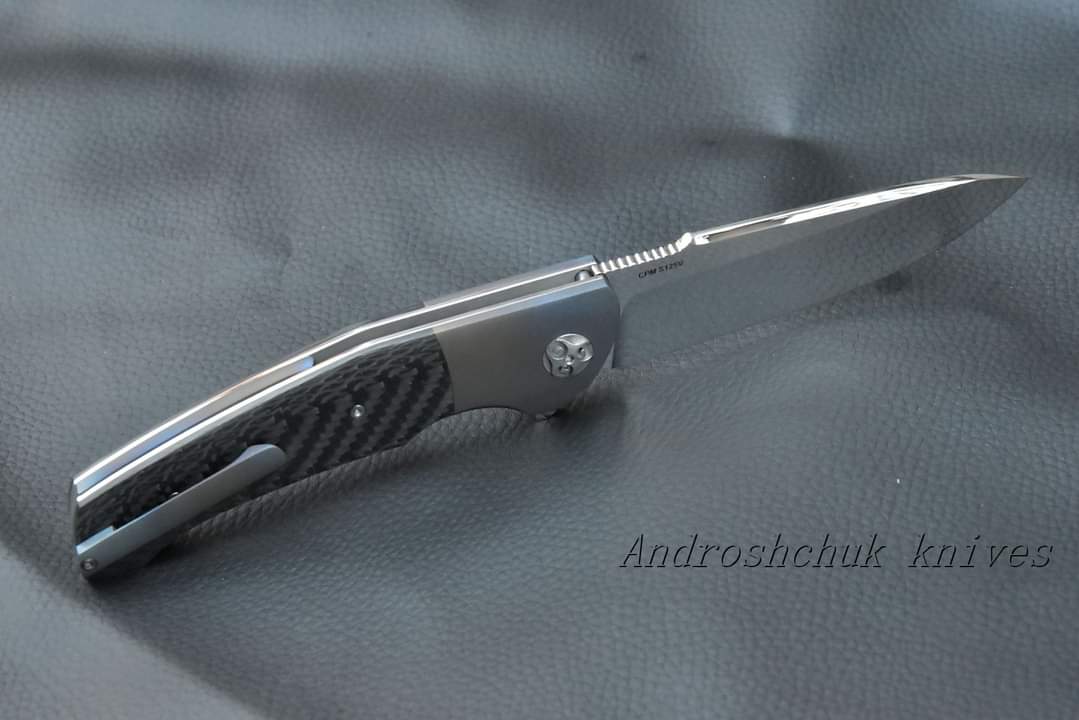
Основу матеріалу складають нитки вуглецевого волокна, середньою товщиною 0,005-0,010 мм у діаметрі. Вуглецеві волокна виготовляються внаслідок складного процесу термообробки. Основне волокно (поліакрил, віскоза) спочатку піддається окисленню повітря при температурі 250 °C протягом 24 годин. У результаті окислення утворюються сходові структури (полімери, макромолекули яких попарно пошиті регулярними хімічними зв'язками). Потім відбувається карбонізація (процес збагачення ниток вуглецем), який проходить при нагріванні волокна серед азоту або аргону при температурах від 800 до 1500 °C. Внаслідок карбонізації відбувається утворення графітоподібних структур (алотропних модифікацій вуглецю). Процес термічної обробки закінчується графітизацією (утворенням графіту в матеріалах, в яких вуглець міститься в розчиненому стані або у вигляді карбідів), вона проходить при температурі 1600-3000 ° C в інертному середовищі. Через війну графітизації кількість вуглецю у волокні доводиться до 99 %. Крім звичайних органічних волокон, для отримання ниток вуглецю можуть бути використані спеціальні волокна із фенольних смол, лігніну, кам'яновугільних та нафтових пеків.

Вуглецеві тканини у свою чергу отримують шляхом плетіння ниток або стрічок. При виробництві цих ниток за основу взято вуглецевий ровінг - джгут із тонких безперервних ниток вуглецевого волокна завтовшки від 3 мікрон, утворених атомами вуглецю. Після переплетення вони складають каркас вуглепластику. Кількість вуглецевого волокна нитки оцінюється числом «К» — кількістю тисяч елементарних вуглецевих волокон. Найтонше і найдорожче вуглецеве волокно - 1К, найбільш поширене вуглецеве волокно 3К, існують також нитки з вуглецевого волокна з К = 6, 12, 24, 48. Тканина, виготовлена з ниток, може мати різноманітний малюнок плетіння (ялинка, рогожа, плетіння та ін). Для надання ще більшої міцності тканини нитки вуглецю кладуть шарами, щоразу змінюючи кут напряму плетіння. Шари скріплюються за допомогою епоксидних смол. Така структура карбону дає можливість армувати волокно додатковими елементами, що зміцнюють його структуру і надають різні кольори і фактуру поверхні. Цими матеріалами можуть бути різні нитки, блискітки, полімерні матеріали різних кольорів.

Основними методами виготовлення карбонових пластин є:
- Пресування, при якому тканина вистилається у форму, попередньо змащену так званим антиадгезивом, призначеним для зменшення зчеплення поверхонь один з одним. Їм може бути мило, віск тощо. Потім тканина просочується смолою, а її надлишки видаляються у вакуумі (вакуум-формування) або під тиском. Після полімеризації смоли виріб набуває закінченого вигляду.
- Вакуумна інфузія дозволяє створювати ламінатний пакет накладенням шарів тканини один на одного і під шари подається вакуумне розрядження. Потім через клапан подається сполучна речовина і під дією вакууму воно заповнює порожнечі і просочує вуглецеву тканину.
- Вакуумне формування, є склеювання шарів при високих температурах і потім вплив вакуумом для формування обсягу виробу. Цей спосіб є одним із найдешевших.
- Метод намотування, який полягає у намотуванні просоченого ровінгу на попередньо підготовлену форму. Після намотування потрібного числа шарів форма з намотаною тканиною поміщається в нагрівальну піч і полімеризується.
- Метод SMC/BMC полягає в приміщенні тканини в прес-форму, нагріту до робочої температури. Прес-форма замикається, у результаті під тиском матеріал розтікається в порожнини форми і твердне. Наприкінці циклу виріб витягується з прес-форми, і виробляється його остаточна механічна обробка та фарбування.
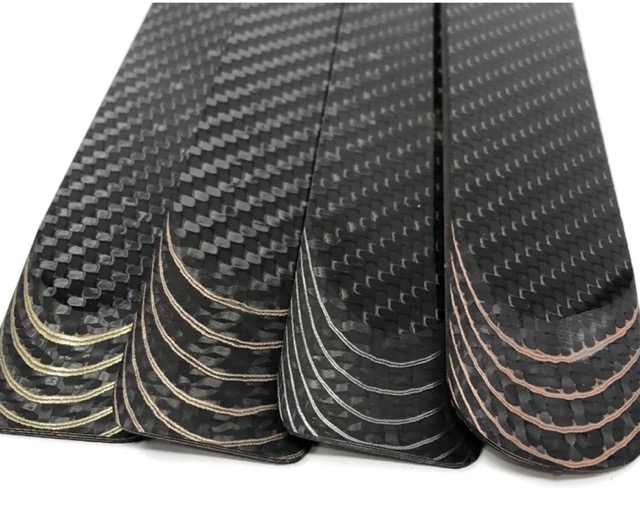
Карбонове волокно застосовується у різних сферах. Зокрема, в авіа та ракетобудуванні, при виробництві деталей корпусу автомобілів та мотоциклів, побутової техніки та високотехнологічних дослідницьких приладів. І вже близько 20 років карбон широко застосовується у виготовленні рукояток ножів середнього та преміального сегмента. При цьому на доладних ножах карбон може бути як у вигляді накладок на сталеві лайнери, так і у вигляді єдиного матеріалу рукояті, закріпленого гвинтами через бонки.
Карбон, що йде на виготовлення ножів, крім своїх основних характеристик міцності, повинен мати ще й досить привабливий зовнішній вигляд. Саме цей фактор збільшує його вартість, ускладнюючи технологію виробництва та вимагаючи найякісніших вихідних матеріалів. Для проклеювання шарів використовуються найдорожчі та якісні смоли, та дорожче обладнання, зокрема хімічні реактори (автоклави). Крім того, для підвищення зчеплення з рукою карбон піддають піскоструминній обробці, що також збільшує витрати на виробництво. Необхідно також пам'ятати, що робота з карбоном вимагає обов'язкового захисту органів дихання та спеціальних приміщень із гарною вентиляцією, і це також веде до зростання ціни.
Колірна палітра та текстура карбону, що використовується на ножах, може бути різноманітною. Серед різновидів карбону застосовуються:
Мозаїчний карбон, який може бути як однотонним, і різнобарвним. Такий карбон застосовується для радіусних проставок на ножах із складними багатосекційними ручками. У цьому карбоні можуть застосовуватися кілька технологій фарбування.
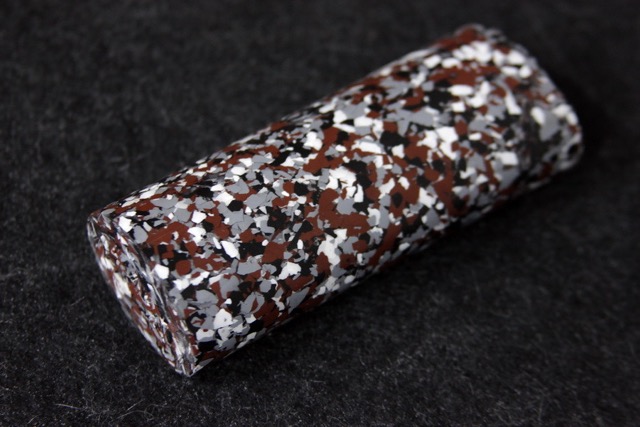
Мармуровий карбон - являє собою хаотичне сплетення карбонових ниток, кожна з яких по-різному відображає світло, що дає йому можливість блищати під різними кутами огляду.

Карбон Lightning Strike («удар блискавки») з мідною ниткою у вигляді сітки, вплетеної у вуглеткань по всьому її об'єму. Зовнішньо аналогічний застосовуваному у фюзеляжах американських літаків для захисту від ударів блискавок. Це тонкий карбон, завтовшки 3,2 мм саржевого плетіння. Має глибокий і яскравий малюнок.
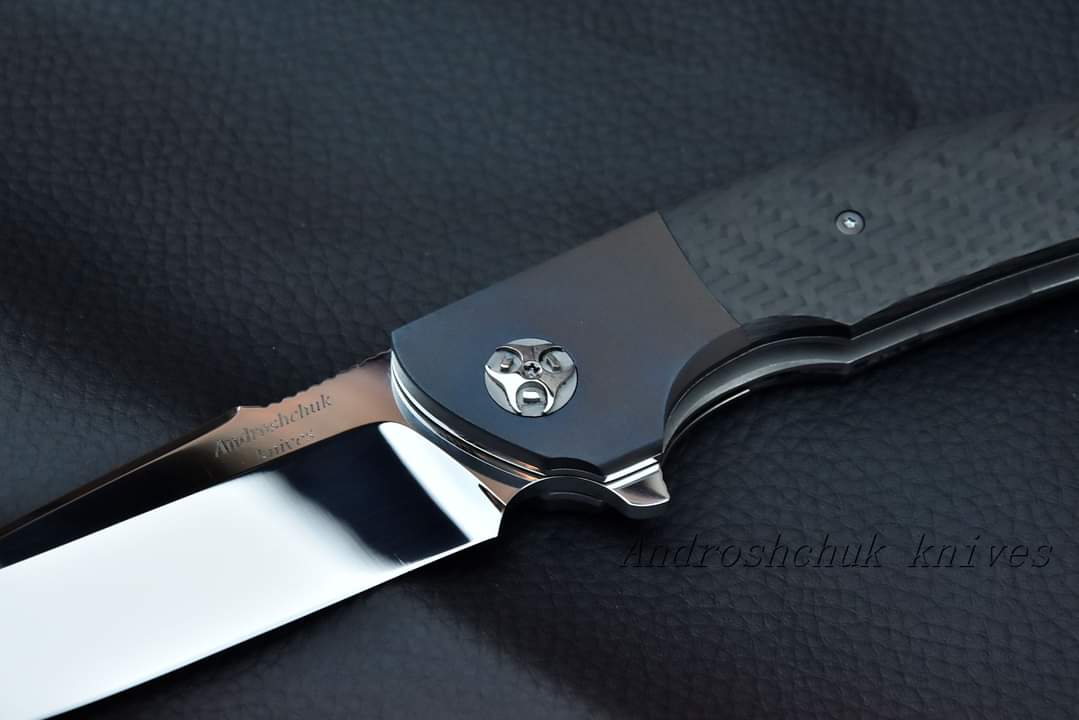
Як і будь-який дорогий і при цьому складний у виготовленні матеріал, карбон має ряд недоліків. При виробництві вуглепластиків необхідно дуже суворо витримувати технологічні параметри, при порушенні яких властивості міцності виробів різко знижуються. Для контролю якості виробів можуть застосовуватись ультразвукова дефектоскопія, рентгенівська та оптична голографія, а також акустичний контроль. Без них виробник працює «на дотик» і може не помітити прихованих дефектів. Іншим серйозним недоліком вуглепластиків є їхня низька стійкість по відношенню до ударних навантажень. Також необхідно пам'ятати, що згодом карбон вицвітає і може суттєво втрачати свою головну перевагу – привабливий зовнішній вигляд. Однак, незважаючи на ці недоліки, карбон по праву є преміальним матеріалом для кращих ножів.
"Дамаск" та "булат" що це тако і чим відрізняються?
Що таке дамаська сталь?
Дамаської - називають сталь, що має чіткий, добре помітний поверхневий візерунок, що є наслідком її неоднорідної, шаруватої внутрішньої структури. Малюнок виділяється у вигляді світлих сталевих ліній на сірому чи чорному тлі. Особливо добре він стає помітним, після протруювання виробу слабкою кислотою. Але іноді буває, що візерунок проявляється після процесу полірування.
Здавна мечам з таким малюнком приписувалися виняткові якості: високі гостроти, гнучкість та міцність. Іноді (особливо на тлі продуктів недосконалих середньовічних технологій) так воно й було. Чому саме «іноді» поговоримо нижче.
На фото: Ніж "Феєричний дамаск" (дамаск).
Навіщо потрібна дамаська сталь і чому вона така?
Як відомо, справжнє залізо насправді зазвичай є сплавом власне заліза з вуглецем.
- Якщо вуглецю в сплаві менше 0.3% метал буде м'яким, пластичним та тугоплавким. Його щось зазвичай і називали власне «залізом». Про якість та властивості цього сплаву можна судити, оцінивши механічні властивості звичайного цвяха.
- При частці вуглецю більше 0.3%, але менше 1.7% виходить сталь. Звичайна сталь дуже схожа за своїми властивостями на залізо. Але має одну важливу відмінність: її можна загартувати. Тобто, при нагріванні, а потім, різкому охолодженні, сталь набуває великої твердості. На жаль, разом з цим вона стає крихкою. У давнину, коли технології одержання сталі та її загартування ще були як слід відпрацьовані, багато вироби з неї (іноді, навіть мечі та обладунки) за своєю якістю мало відрізнялися від, наприклад, напилка радянського виробництва. Такий напилок міцний і твердий, але спробуйте впустити його на підлогу або вдарити, і він, швидше за все, лусне.
- Ну а якщо вміст вуглецю в металі підніметься вище 1.7%, вийде чавун. Чавун легко плавиться, добре підходить для лиття, але твердий, тендітний і не піддається ковці. Чавунна труба, що впала навіть з невеликої висоти - розлітається вщент.
У результаті бачимо, що залізо надає сплаву пластичність і підвищує температуру його плавлення. Підвищення вмісту вуглецю в металі дає твердість, аж до крихкості, робить матеріал більш легкоплавким.
Ковалі та металурги завжди прагнули поєднати у своїх виробах ці дві суперечливі якості – пластичність та твердість так, щоб вони доповнювали, а не спростовували один одного. До того ж, вкрай важливою властивістю вважалася пружність, яку спочатку не мав жоден із зазначених сплавів.
За старих часів знаряддя з чистого заліза виходили надто м'якими, а з пережареної сталі того часу – дуже крихкими.
Ми не знаємо, якому генію спало на думку об'єднати два цих сплави у свого роду «бутерброд» і тим поєднати в одному виробі властивості різних матеріалів. Але це був однозначно геній схожий на винахідника колеса або багаття.
Таким чином, при виготовленні клинка шар твердої сталі закладали між двома шарами м'якого заліза і проковували. В результаті отримували виріб, який, завдяки такій «шаровій» структурі, був міцніший за суто залізний і пластичний, ніж твердий, але тендітний через невдале гартування, сталь тих років.
Знаряддя та інструменти із чистого заліза виходили надто м'якими, а з чистої сталі – надто крихкими. Тому, щоб виготовити, наприклад, меч, доводилося робити бутерброд із двох пластин заліза, між якими закладалася сталева пластина.
Таку сталь називали звареною.
На фото: Ніж мисливський "Морська крапля". Клинок виготовлений з мозаїчного дамаска.
Дамаск є подальшим розвитком цієї технології. Комусь (швидше за все, в Індії) спало на думку, що якщо у виробі буде більше шарів, що чергуються, воно стане ще гнучкішим і міцнішим.
Спосіб отримання такої сталі був досить трудомісткий - залізну заготівлю розковували в довжину, складали навпіл, потім знову розковували і знову складали. Цю дію повторювали часом десятки разів. Тридцять чи сорок повторень нікого б не здивували. Хоча навряд чи хтось почав би ділитися такими тонкощами технології. Довгий час майстри зберігали її в найсуворішому секреті.
Надалі були вигадані інші, кілька (зовсім трохи) менш трудомісткі способи. Але принцип дії завжди залишався приблизно той самий.
В результаті виходила заготівля, в якій безліч найтонших високо і низьковуглецевих шарів створювали дивовижну структуру, що має нові властивості. Саме змішання шарів породжує той красивий малюнок, який відрізняє дамаську сталь. Саме структура та особливість розташування шарів задають якості клинка. Визначають поєднання в ньому міцності та гнучкості.
До речі, для наметаного ока малюнок стали сказати багато про що. Так, відомий середньовічний арабський знавець зброї Аль-Кінді писав: «Дивлячись на візерункову сталь, бачиш її як зовні, так і всередині». А, мабуть, один із найкращих європейських знавців булатних і дамаських сталей, П.П. Аносов стверджував, що «...досвідчений азіатець не помилиться у виборі клинка і по одному в
зору визначить, в'язок булат чи тендітний, твердий чи м'який, пружний чи слабкий».
Цікаво, що сучасні фахівці часто стверджують зовсім протилежне, мовляв, «якість стали ніяк не пов'язана з малюнком на ній». Швидше за все, цей цікавий курйоз пов'язаний з тим, що давно відомі способи хімічного та механічного нанесення дамаскового малюнка на поверхню будь-якого шматка сталі, навіть звичайної залозки, що ніколи й не лежала поряд з ковальським гірником. Звичайно, в наш час такі підробки стали надзвичайно поширеними.
До того ж, з-під молота «майстра», який не знає всіх особливостей виробництва, цілком можуть виходити заготовки з малюнком, як у справжнього дамаска, але не піднімаються за своїми характеристиками вище за цілком ординарну сталь. І тут, щоб розібратися, мабуть треба бути вже справжнім знавцем, не гіршим за Аносова чи Аль-Кінді.
Отже, по-перше, з усього сказаного ми можемо зробити висновок, що дамаські сталі можуть бути різної якості, і це залежить від внутрішньої структури шарів і, звичайно ж, майстерності коваля.
А по-друге, зауважуємо, що поряд із словом "дамаск" вживається ще й слово "булат". Ось про це, мабуть, варто поговорити окремо.
На фото: Ніж мисливський "Мозаїчний дамаск"
Що таке "булат" і чим він відрізняється від "дамаска"?
Жодної єдиної термінології за старих часів не існувало, зате було безліч різноманітних місцевих традицій. До того ж, засоби передачі були дуже недосконалі. З цієї причини слова та поняття постійно змінювалися та спотворювалися, породжуючи немислиме за своєю заплутаністю та нелогічністю різноманітність.
Нам, які звикли до однозначності термінів, слід постійно пам'ятати про це, коли ми маємо справу з різними поняттями та уявленнями наших предків.
Дорогу та якісну сталь у різних країнах і різні часи називали по-різному. "Дамаск", "булат", "вутц", "харалуг", "табан", "хорашан", "шам" - назв цих не перелічити.
Так, довгий час найвищої якості сталь взагалі на території Російської Імперії називали саме «булатом» (булатною сталлю). І, мабуть, зовсім не замислювалися, що це слово походить від іранського «пулад», що позначав литу сталь.
Як пише в книзі «Зброя з Дамаска і булату» В. Н. Хореєв: «Булат - це сталь з аномально високим (порядку 2% і більше) вмістом вуглецю, що володіє комплексом несумісних у звичайному металі властивостей, а саме - максимально можливою твердістю і щільністю у поєднанні з такою ж високою пластичністю. Отримують натуральний булат шляхом плавки, коли з печі виходить невеликий готовий злиток, що спочатку несе в собі чарівну внутрішню структуру.»
На фото: Ніж мисливський "РИСЬ 3" (дамаск).
Слово ж "дамаск", можливо (але не точно) походить від іншого арабського "дамаст", що опанчає "хвилястий", "струменевий". Не виключають, що назва ця походить від різноманітних асоціацій зі Сходом і строкатим малюнком знаменитих дамаських тканин. Як завжди в таких випадках, точно вже ніхто не скаже.
Головне ж, що ми бачимо, так це те, що булат і дамаск стали одержувані за допомогою абсолютно різних технологій. Так як плавити залізо в більшості регіонів нашої планети довгий час взагалі не вміли, булат був ще рідкішим, ніж зварна візерункова сталь.
З цієї причини застосування терміну «булат» до «дамаска» є явним результатом плутанини і, швидше за все, наслідком того, що справжній булат на території Російської імперії взагалі мало хто бачив.
До речі, малюнок на литому булаті також може бути красивим і приємним оку. Вважається, що він закладався ще за кристалізації зливка. Відбувалося це тому, що залізо і вуглець, як ми вже писали, мають різні температури плавлення. Надалі, при куванні, цей малюнок міг виявитися тим чи іншим чином. Але, до речі, деякі фахівці стверджують, що саме дрібнозернисті, позбавлені візерунка сорту литого вутца (як його називали самі індуси) були найкращими.
На жаль, але в місці винаходу булату - в Індії секрети його отримання ховали так старанно, що зрештою втратили їх зовсім. А. Василенко у своїй статті «Булатна сталь» стверджує, що: «Вже до кінця ХII століття клинки з литого булату найвищої якості… не вміли робити ні в Індії, ні в Сирії, ні в Персії».
Наприкінці XVIII століття, індійські металурги виявилися розореними ввезенням дешевого заліза з Англії, і всі сподівання відновлення втраченої традиції її батьківщині випарувалися остаточно.
З того часу секрет отримання «того самого булату» шукали металурги багатьох країн. Періодично було чути радісні заяви, що секрет легендарного «вута» розгадано. Але чи це справді той самий сплав, вам уже не скаже ніхто.
Проте, навіть у наш час деякі виробники випускають лімітовані серії ножів, клинки яких заявлені як булатні. Буває це рідко, ножі такі вкрай дорогі. Одним із таких виробників є, наприклад, фірма Herbertz Limited Edition.
На фото: Ніж "ОЛЕНЬ" (дамаск).
Чи роблять у наш час ножі зі звареного дамаску?
Так, роблять. Саме кований дамаск, завдяки своїй красі і навколишнім легендам, вкрай популярний досі. До того ж спосіб його виробництва давно вже не є секретом.
Деякі ножі зі справжнього кованого дамаска ви можете побачити та купити і в інтернет-магазині Grand Way, причому порівняно недорого. За цілком розумну суму ви можете стати власником ножа, за який у давні часи віддали б невелику череду коней або неабияку ділянку землі.
Для ножів з дамаска у нас відведено окрему категорію.
Який буває дамаск?
Працюючи з дамаском можливе отримання безлічі різних візерунків. Меж для фантазії майстра тут майже немає. Ковалі, що працюють із дамаськими сталями, зазвичай не зупиняються в експериментуванні, шукають нові форми візерунка та методи їх отримання.
Різні види дамаска відрізняють насамперед за особливостями малюнка. Так, розрізняють смугастий, сітчастий та хвилястий дамаски.
Досить рідкісним, а тому дуже цінним за старих часів вважався колінчастий візерунок по всій ширині клинка. На Сході найбільше виділяли сорти табан («блискучий») та хорасан («схід сонця»). Це були дуже якісні дамаски, з напрочуд гарним візерунком: по темному з золотистим відливом тлі йшли ясно помітні, чіткі світлі лінії, що утворювали великий колінчастий або сітчастий малюнок.
Загалом від зазначених основних типів розходиться ціле дерево варіантів і форм. Майстри не припиняють експерименти та пошуки, тому й різноманітність малюнків лише зростає.
На фото: Клинок ножа ВЕДМЕЖА ЛАПА (дамаск) є чудовим прикладом так званого полосчастого дамаска.
Чи є у дамаської сталі недоліки?
Звісно, недоліки у цьому світі мають усі. Винятків немає.
Головним недоліками дамаска за всіх часів були трудомісткість виготовлення та велика витрата матеріалу. Вважається, що у середньовічних майстрів, в ході десятків проковок заготівлі, що повторюються, та втрачала до 85% ваги, поки остаточно не перетворювалася на дамаск.
Через таку значну витрату матеріалу, часу та сил, вироби з такої сталі завжди були дуже дорогими. До того ж, на зростання ціни впливала і секретність технологій, обмеженість кількості майстрів, здатних виготовляти такі мечі.
Другий недолік - неабияка схильність дамаска корозії. Причина цього сумного факту - високий вміст вуглецю і майже повне остутсвие легуючих елементів у цих сортах сталі.
Тому мечі з дамаска, як дорогі жеребці - завжди потребували особливо ретельного догляду.
Після використання їх необхідно добре витирати насухо. Зберігати далеко від вогкості. А у разі появи іржі, негайно прибирати її доступними засобами (гас, наждачний папір та ін.)
Чи існують у наш час стали кращі, ніж дамаск та булат?
Мабуть, найбільш явно таємниця булату була розкрита сучасною цивілізацією тим самим Аносовим в 1830 року. Багато розумів Європи билися над цією проблемою, але тільки в Аносова для експериментів під рукою виявився тагільський магнетит.
Однак, незабаром після цього відкриття, були розроблені більш досконалі, технологічні та дешеві способи отримання сталей, що поєднують у собі властивості міцності та пружності. Ці сорти стали може і не завжди були кращими за литий булат за всіма показниками, але вони безумовно склали йому більш зручну у виробництві альтернативу.
Прогрес не стоїть на місці. Технології двадцятого і двадцять першого століття, а також глибокі пізнання сучасних вчених у фізиці та хімії подарували нам сталі та сплави просто неймовірні та немислимі для давніх ковалів. Мало того, вони зробили вироби з цих сталей доступними не тільки королям і шахам, а й фактично майже всьому людству.
Наприклад, у магазині Grand Way, ви зможете знайти чимало моделей ножів, які за якістю не поступляться багатьом клинкам із стародавніх легенд та оповідей.
Так, клинок складаного ножа CH 3510 від CH Knives виготовлений з 154CM - чудової американської сталі з високим вмістом вуглецю. Цю марку стали спочатку розробили для виробництва турбін. Але поєднання її характеристик виявилося таким привабливим для найфмейкерів, що ця сталь тепер ґрунтовно закріпилася в ножовій індустрії. 154CM використовують ножові бренди та окремі майстри по всьому світу.
Справа в тому, що структура і хімічний склад цієї марки сталі дозволяє гартувати її до високих показників твердості (зазвичай, близько 60HRC) без втрати в'язкості. Сталь при цьому не стає крихкою. А отже, такий клинок можна зробити надзвичайно гострим, але він все одно чудово чинитиме опір і фарбуванню, і механічним навантаженням.
Звичайно ж, 154CM, як і все більш високовуглецеві сталі при тривалому контакті з водою або агресивними середовищами, може іржавіти. Але при належному догляді, сто п'ятдесят четверта показує себе з найкращого боку.
Клинок зі сталі 154CM дозволяє ножу CH3510 по праву займати місце в списку дійсно топових, преміумних моделей, що продаються в інтернет-магазині knife.net.ua. Варто зауважити, що якісний рівень збирання цього ножа так само адекватний його високому статусу.
Не менший інтерес у цьому плані представляє і ніж S3 puukko flipper від Real Steel. Його меч виготовлений з мартенситної хромистої порошкової сталі преміум-класу Böhler M390. Ця сталь відрізняється високими показниками співвідношення міцності і в'язкості, вона добре тримає гостроту ріжучої кромки і стійко протистоїть механічним навантаженням. І що найголовніше, при всьому цьому – вона чудово пручається корозії!
Böhler M390 – сталь найвищого класу. Ножі з неї випускають обмеженим тиражем (згідно з даними Real Steel knives USA, серія S3 puukko flipper - 600 штук). Тому на обух кожного екземпляра нанесений особистий серійний номер, який також вписаний у паспорт, що додається до ножа.
Чи зберігає дамаск своє значення у наш час?
І так і ні. Причому романтичне «так» тут явно переважує сухе практичне «ні».
Звичайно, отримання кованого дамаска більше не є єдиним доступним способом отримати якісну сталь для клинка.
Але ось що нікуди не пішло, то це естетичне і культурне значення цієї сталі. Ніж з мечем з дамаска все ще залишається дуже гарною річчю. Бажаним поповненням колекції та престижним, цінним подарунком.
Легенди ж, що оточують мечі з дамаської сталі, лише додають їм винятковості та значущості в очах людей. Адже купуючи такий ніж, ви купуєте не просто якісний різальний інструмент, ви купуєте частину легенди, невеликий шматочок славної історії людства, нагадування про часи геніальних майстрів ковальської справи, великих королів і славних героїв.
Такі цінності вічні й у грошах їх, мабуть, не рахувати.
Ніж зі сталі CPM-S90V
Нож со стали CPM-S90V
/EXELSIOR%20S90V%20%D0%BD%D1%96%D0%B6%20%D1%80%D1%83%D1%87%D0%BD%D0%BE%D1%97%20%D1%80%D0%BE%D0%B1%D0%BE%D1%82%D0%B8%20%D0%BC%D0%B0%D0%B9%D1%81%D1%82%D1%80%D0%B0%20%D1%81%D1%82%D1%83%D0%B4%D1%96%D1%97%20Androshchuk%20Knives%2C%20%D0%BA%D1%83%D0%BF%D0%B8%D1%82%D0%B8%20%D0%B7%D0%B0%D0%BC%D0%BE%D0%B2%D0%B8%D1%82%D0%B8%20%D0%B2%20%D0%A3%D0%BA%D1%80%D0%B0%D1%97%D0%BD%D1%962.jpg)
Таким чином, ексклюзивні ножі ручної роботи knife.net.ua відрізняються високою міцністю та можуть витримувати досить великі навантаження та при цьому чудово зберегти заточування. Мають відмінні антикорозійні властивості і не вступають у реакції з більшістю лугів та кислот, тобто особливого догляду цим ножам не потрібно, що робить їм величезний плюс при використанні на природі, полюванні, риболовлі та/або в екстремальних умовах*. Мабуть, єдиним мінусом ножів зі сталі M398 є їхня вартість, яка досить висока і треба бути до цього готовим.
Варто пам'ятати, що при використанні ножа за призначенням та дбайливим поводженням, ніж прослужить Вам дуже і дуже довго.
Купити ножі можна на нашому сайті knife.net.ua або зв'язавшись з нами за телефоном +380961711010
Кап клена
Кап - це наріст на стовбурі дерева, він має значно щільнішу структуру з абсолютно неповторним малюнком зрізу.
Кап відрізняється високою міцністю, деревина капа погано горить, добре обробляється і полірується.
Розміри заготовок приблизно 135-45-30 мм.
Бруски стабілізованої деревини чудово підходять для створення стандартних рукояток ножів із наскрізним та всадним монтажем.
Також стабілізований кап клена відмінно підходить для різьблення, створення мініатюр, прикрас, а також різних кулонів, амулетів, іграшок та виробів.
Зі стабілізованим капом клена зручно працювати як досвідченим майстрам, так і початківцям.
Стабілізована деревина будь-якого кольору це прямі, рівні бруски справжнього дерева - капа клена, просоченого спеціальним складом.
Засіб для стабілізації дерева заповнює повністю всі дрібні пори, завдяки чому з дерева виходить все повітря та волога, перетворюючи його на полімеризований брусок стабілізованої карельської берези, тільки з удосконаленими властивостями.
Стабілізоване дерево в рази важче і набагато щільніше. Воно не піддається впливу вологи, не змінює свій колір під сонячним промінням, залишаючись набагато міцнішим і надійнішим матеріалом.
Все це робить стабілізацію ідеальним матеріалом для створення предметів, що піддаються всім фізичним та кліматичним навантаженням – рукоятей ножів, різців та різних інструментів.
Стабілізований кап клена чудово шліфується, даючи гладку, як скло чи камінь, поверхню. Без покриття в сухому вигляді стабілізовані бруски мають бляклий вигляд, проте під фінішними складами розкривається їхня яскрава глибока текстура.

За неповторну красу кап називають дерев'яним малахітом!
Загалом — чим дрібніший малюнок і більший розмір капа, тим він дорожчий.
Про цінність цього унікального матеріалу говорить історичний факт, наведений у книзі «Капова скринька» (автор Надія Пермінова): «… у 1837 році за наріст капа в двадцять фунтів (трохи більше 8 кг) платили до п'ятдесяти рублів… такою самою сумою оцінювався породистий бик на сільськогосподарській виставці.
Сьогодні на світовому ринку ціна на капову деревину (масив та шпон) у рази перевищує ціну на будь-яку, іншу, включаючи: дуб, в'яз, горіх, червоне дерево та будь-які екзотичні породи.
Унікальне поєднання властивостей матеріалу, обмеженість запасів і неповторність капового малюнка в кожному виробі, зрештою, і визначило загальновизнану, високу естетичну цінність та відповідну споживчу ціну виробів з цієї деревини, яка застосовується в обробці найрозкішніших інтерєрів.
G10 — в ножах ручної роботи Павла Гончаренка: якість, стиль, сучасність
Що це за матеріал?
G10 — легкий і твердий матеріал, який характеризується поверхнею текстурованою і особливою практичністю. Його використовують для створення рукояток на різних видах ножів – складні та цілісні, з додатковими елементами.
В основі — армований під тиском склотканиною компаунд. Волокнистість структури надає матеріалу жорсткості. Для підвищення важливих експлуатаційних характеристик при виготовленні рукояток до складу додатково додаються спеціальні хімічні сполуки, що зміцнюють. Матеріал не горючий, має більш високі характеристики міцності — на вигин, розрив і удар.
G10 формується за шарами. Це дозволяє фарбувати накладку в один або кілька кольорів, створюючи цікаві візуальні ефекти багатошаровості виробу. Зовні він нагадує мікарту — ще один популярний матеріал, з якого виготовляють накладки ножів ручної роботи «РоС»
Особливості виробництва накладок з G10
Більшість виробників піддають готові накладки з G10 піскоструминної обробки, що оголює структуру скловолокна. У результаті рукоятка набуває шорсткої поверхні, завдяки чому виключається ковзання в руці і забезпечується комфортне і безпечне використання ножів. Після фінішної обробки поверхня накладки може потьмяніти. Для відновлення яскравого, ефектного зовнішнього вигляду на останній стадії виготовлення вона покривається олією або полірується.
Майстер використовує накладки для рукояток із G10 з різними ножовими сталями – ATS 34, CPM154CM, D2, 440C, CPM S30V, 40Х13.
Переваги матеріалу
Цей сучасний матеріал має такі переваги:
- легко витримує навантаження на гнучкість та розтягування;
- має стійкість до ударних навантажень;
- не вбирає вологу;
- відрізняється високою густиною;
- стійкий до радіації та впливу хімікатів;
- має низьку електропровідність;
- не розсихається та не деформується;
- стійка перед високими температурами.
Ще одна перевага даного матеріалу — відмінне співвідношення механічної міцності та малої ваги. Це дозволяє отримувати міцні накладки з хорошими експлуатаційними характеристиками, які не обтяжують ножі.
Якісні та оригінальні накладки з G10 стали чудовою прикрасою ексклюзивних та неповторних ножів майстерні Студія "Ножі ручної роботи Павла Гончаренка" (Україна), який пропонує замовити та купити інтернет-магазин https://knife.net.ua
Морений граб що таке. Листопадне дерево граб та його незвичайні властивості
Опис
Характеристика деревини
Чорний граб
Перед застосуванням будь-яких видів кріплення потрібно попереднє свердління матеріалу. Шурупи та цвяхи він тримає чудово, що добре підходить для забезпечення з'єднань меблів та складних деталей.
При використанні свіжої деревини в побуті виробу рекомендовано вирізувати і обточувати, доки матеріал не висушений, - у такому вигляді його простіше обробити.
Незважаючи на природну високу щільність та зносостійкість, граб вважається досить складною і малопрактичною породою, оскільки швидко розмокає, схильний до ураження грибком та іншими біологічними патогенами. Без додаткового протруювання та оздоблення він не застосовується, не підходить і для зовнішніх робіт. Звита структура волокон і низька здатність до склеювання не дозволяє використовувати граб як конструкційний будівельний матеріал: фанери або клеєного бруса. Для зовнішніх робіт не застосовують. Усередині приміщень поверхня з граба повинна покриватися захисними просоченнями та товстими шарами лаку. Не варто використовувати матеріал у кімнатах із високою вологістю.
Сфери та особливості застосування
Своє призначення ця деревина знаходить там, де потрібна стійкість до ударних навантажень: у виготовленні декоративних елементів, деталей механізмів, предметів спортивного призначення. З неї виробляють:
ключки для гольфу, більярдні киї;
ткацькі човники;
сільськогосподарські знаряддя праці;
корпуси та елементи грифів скрипок, гітар, деталі роялів, інших музичних інструментів;
обробні дошки, ручки ножів;
скриньки, іграшки, сувеніри, рами для картин, панно та фотографій;
меблі, паркет, деталі оформлення інтер'єру.
Завдяки благородному світло-перлинному забарвленню та міцності, деревина граба має високу художню цінність і використовується у створенні мозаїчних малюнків, фризів та елементів декору.
З грабу виробляють деталі повітряних гвинтів у літакобудуванні.
У середньому ціна на 1м³ деревини, залежно від виробника, становить 645–800 доларів.
Вважається, що меблі або обробка з цього виду деревини позбавляє втоми, надає фізичних сил, допомагає скоординувати думки і дії, позбутися поганого настрою.
Чорний граб
Світла структура дерева з маловираженим природним малюнком робить його привабливим виготовлення різних імітацій. Методом протруювання матеріалу отримують чорний граб, який за властивостями та зовнішнім виглядом подібний до ебенового дерева. Для якісного фарбування застосовують нігрозини – спеціальні суміші на основі аніліну, нітробензолу та соляної кислоти, розчинені у воді чи спиртах. Вони надають матеріалу чистого яскравого кольору, який не боїться впливу прямих сонячних променів. Професійне протруювання передбачає наскрізне забарвлення всієї товщі матеріалу, а не поверхневе нанесення фарби. Самостійно протравлювати деревину не рекомендується, тому що при використанні самопальних хімічних барвників вона може втратити міцність, стати пухкою або профарбуватися нерівномірно. Майстерно виготовлений, імітований під ебен чорний граб має дуже темний фіолетовий відтінок, що не вигорає і не линяє з часом, не мажеться при механічному впливі на поверхню. Чорний граб продається малими партіями як невеликих брусків.
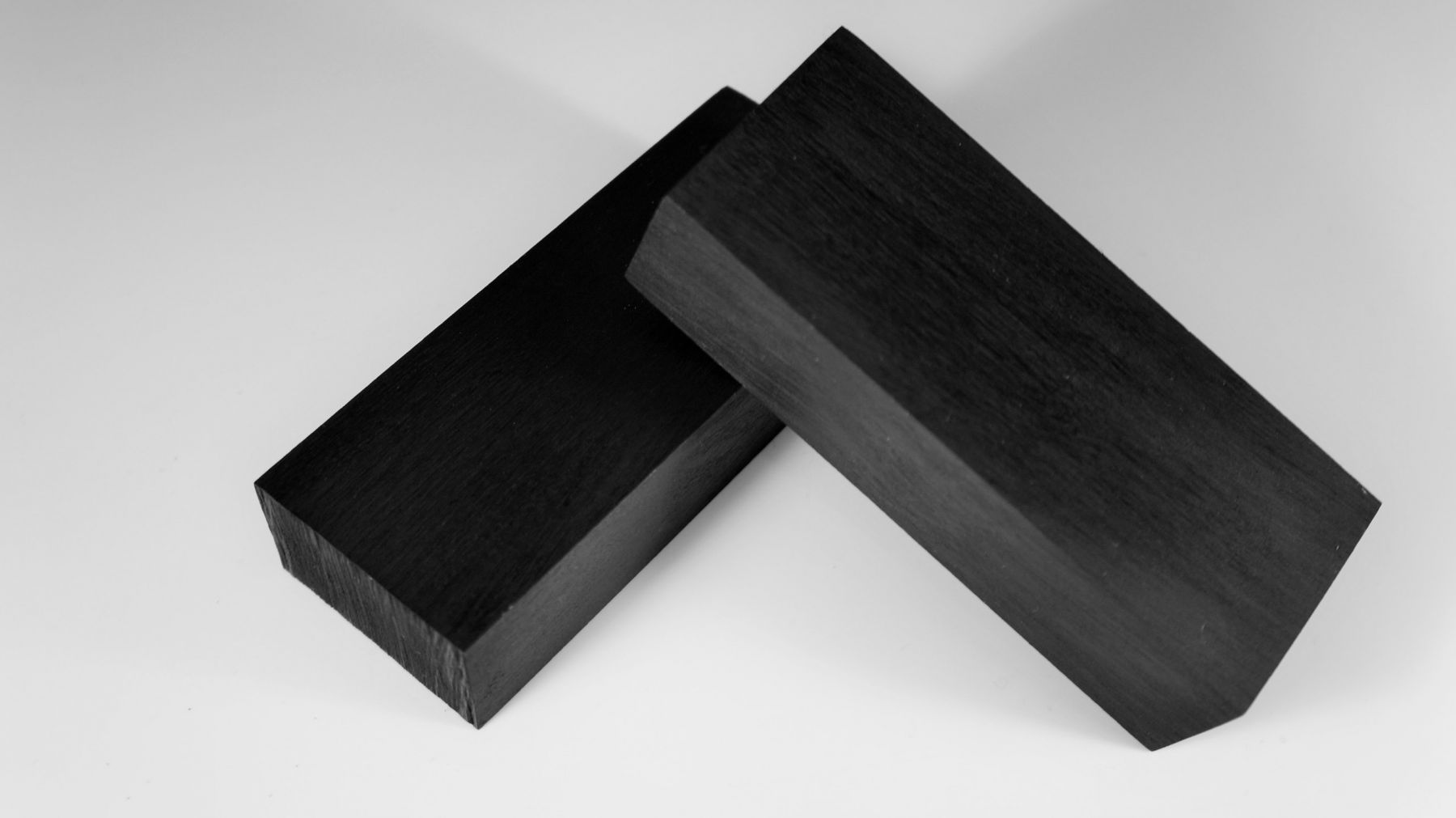
Рекомендовані товари









Доставка і оплата
Доставка і оплата
Доставка Новою Поштою
Швидкість доставки в будь-яке відділення Нової пошти в Україні фіксується оператором, але зазвичай не перевищує 1-3 календарних днів.
Готівкою
Оплата готівкою при отриманні товару.
Післяплатою на Новій Пошті (при собі необхідно мати паспорт або водійське посвідчення).
Visa и MasterCard
Оплата замовлення на карту Приват Банку.
Доставка товару можлива тільки після підтвердження платежу.
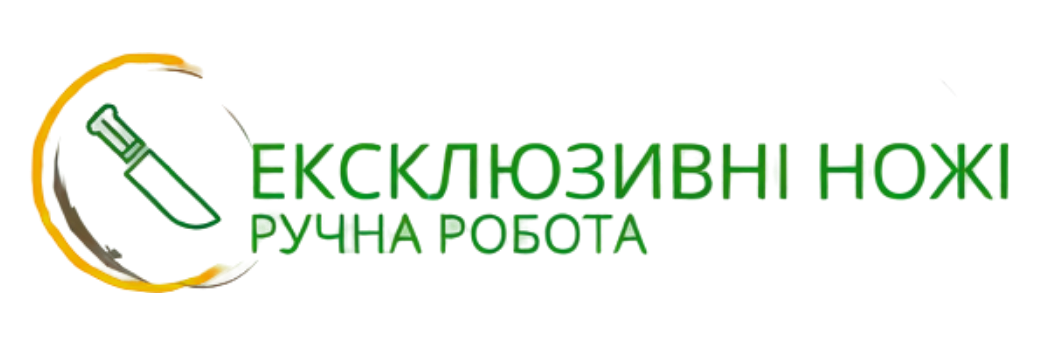



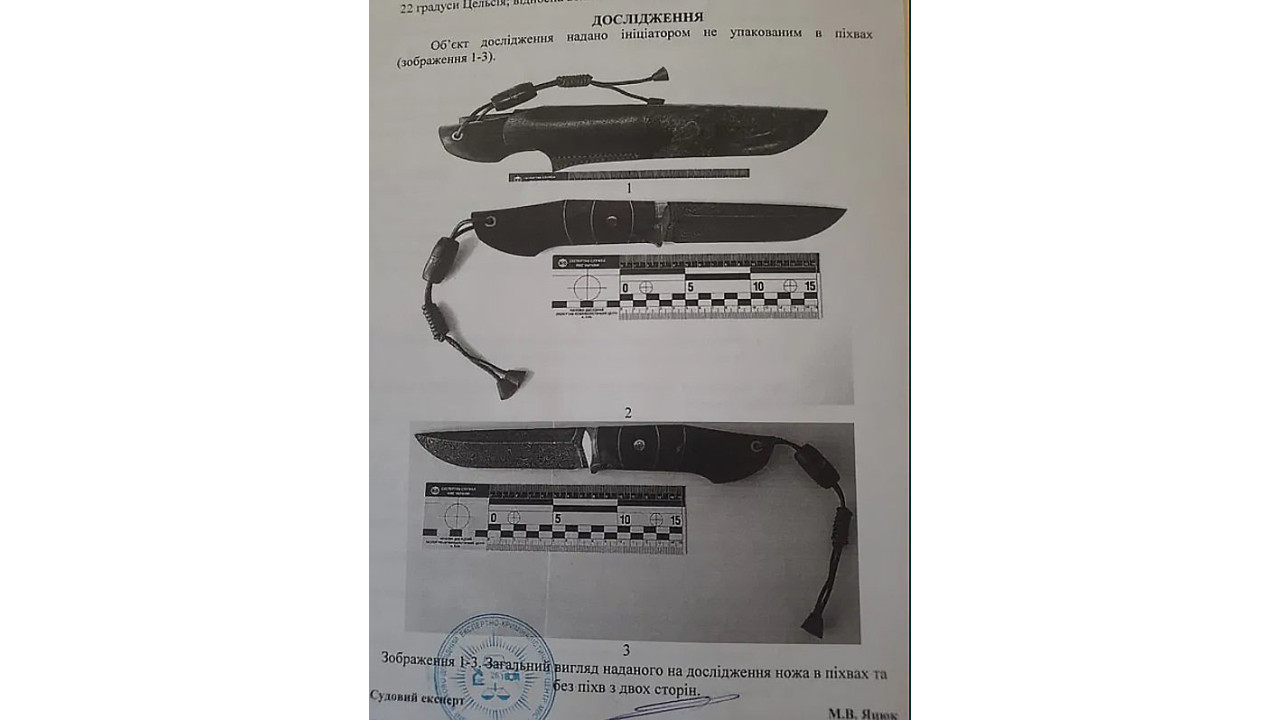









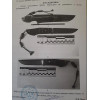









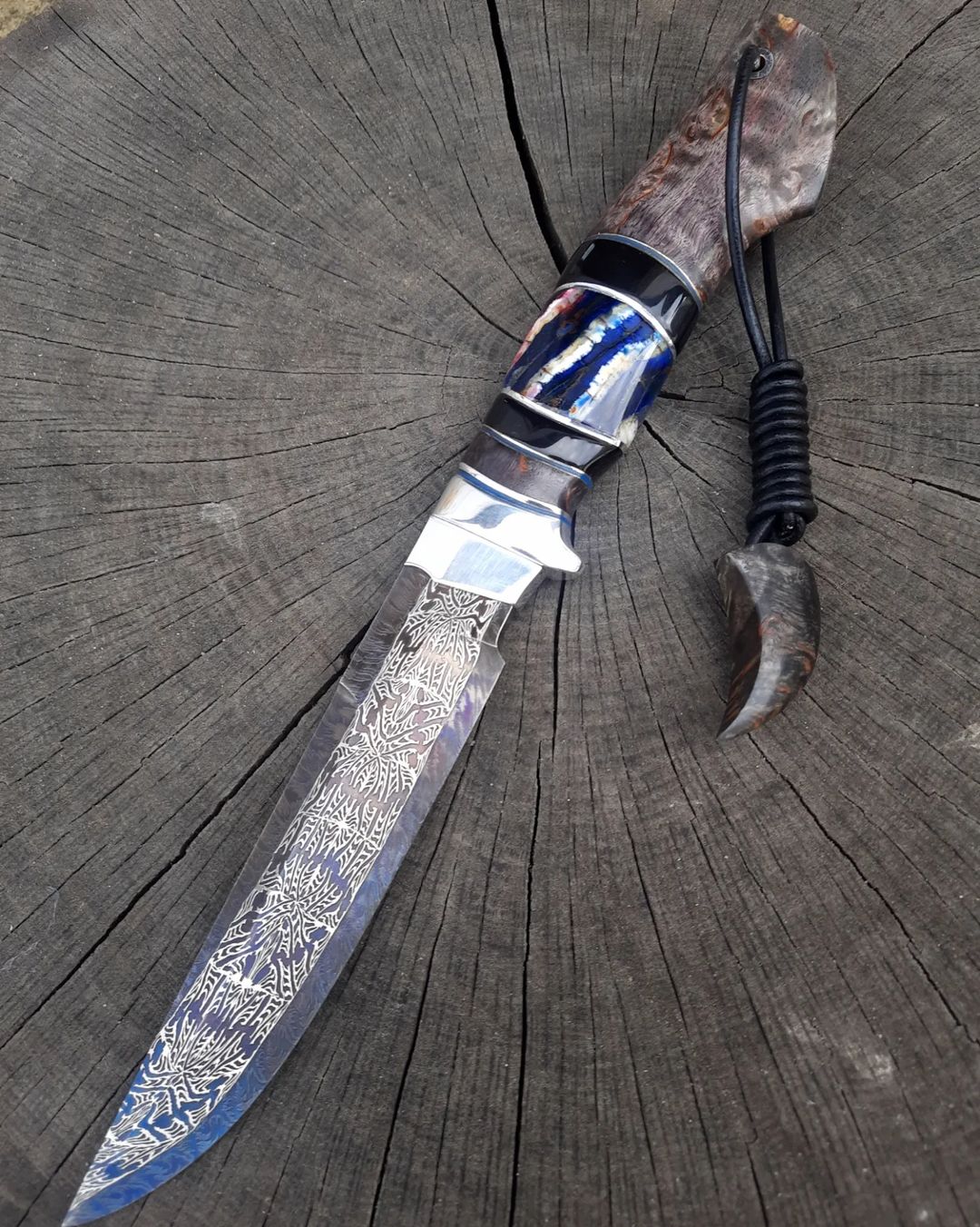
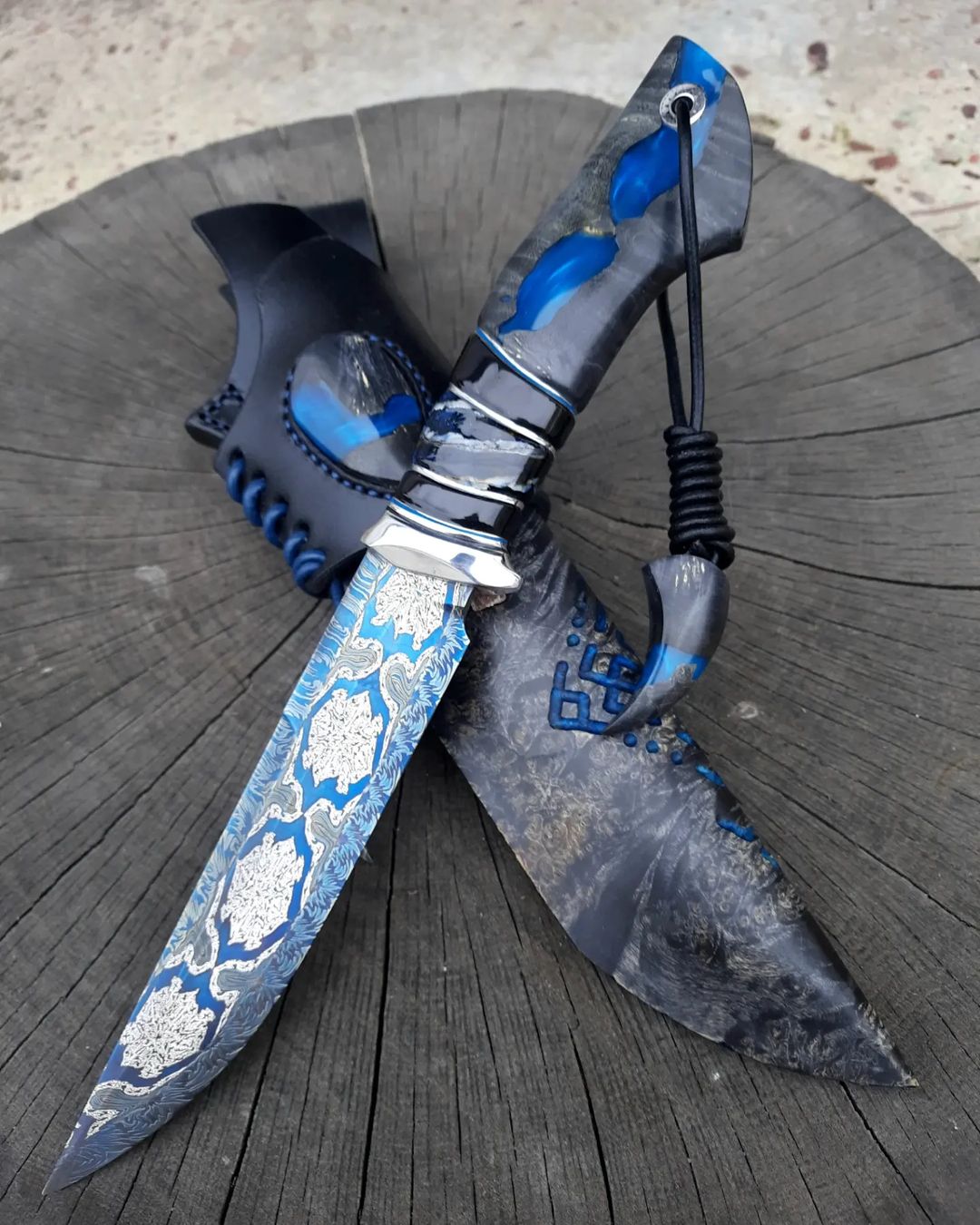
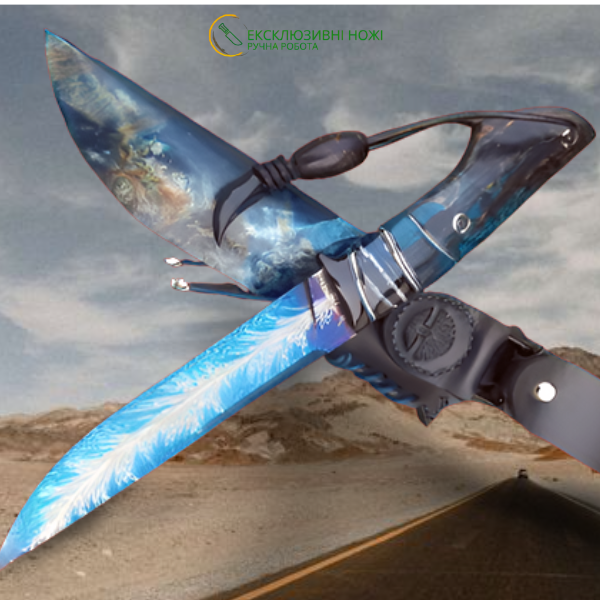
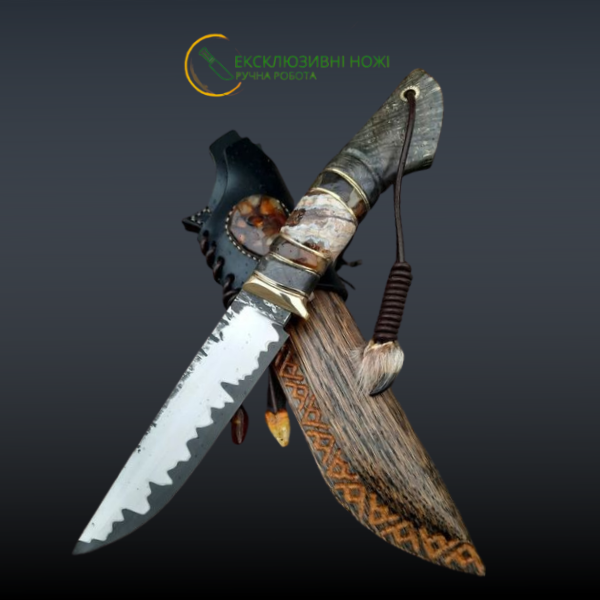
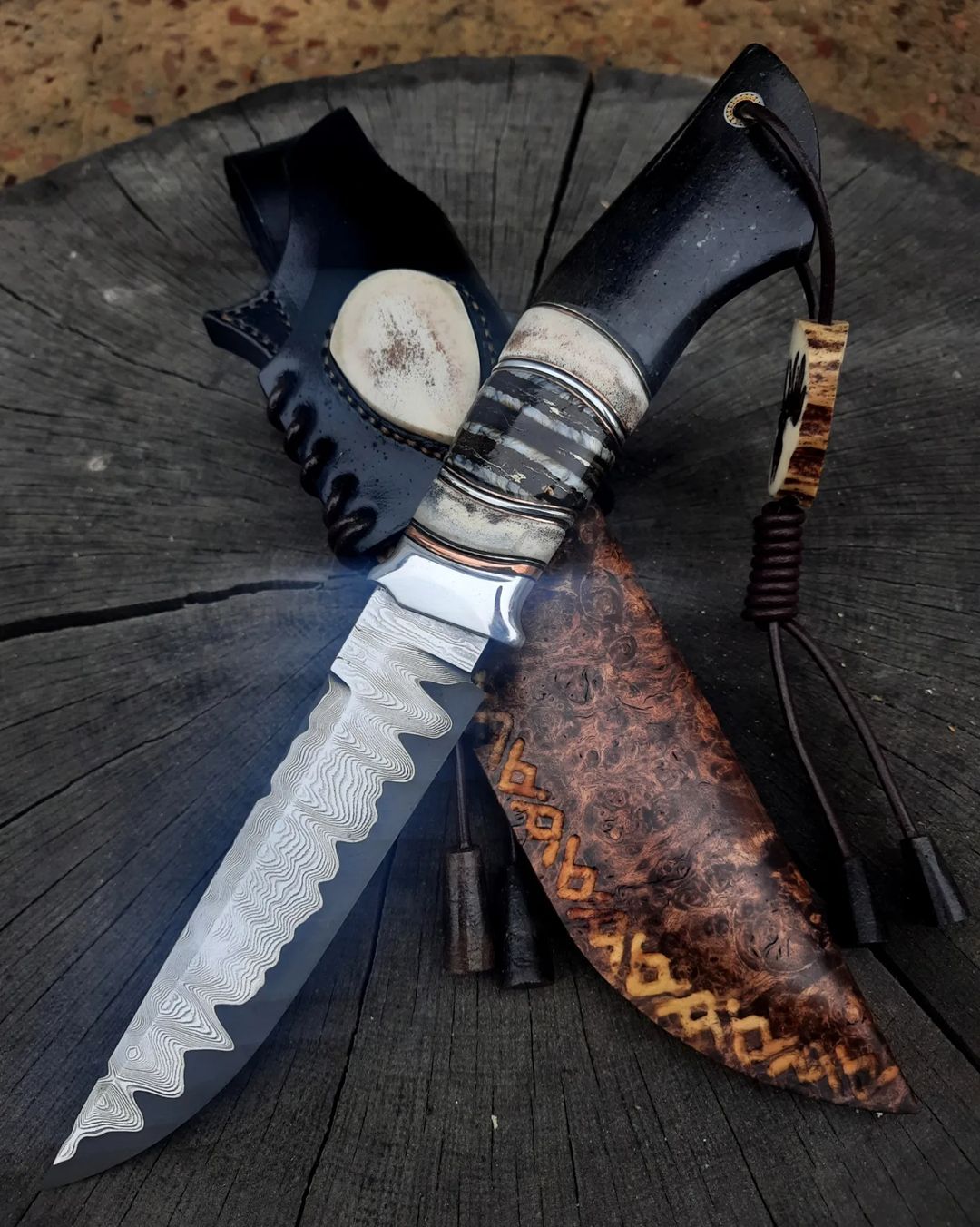
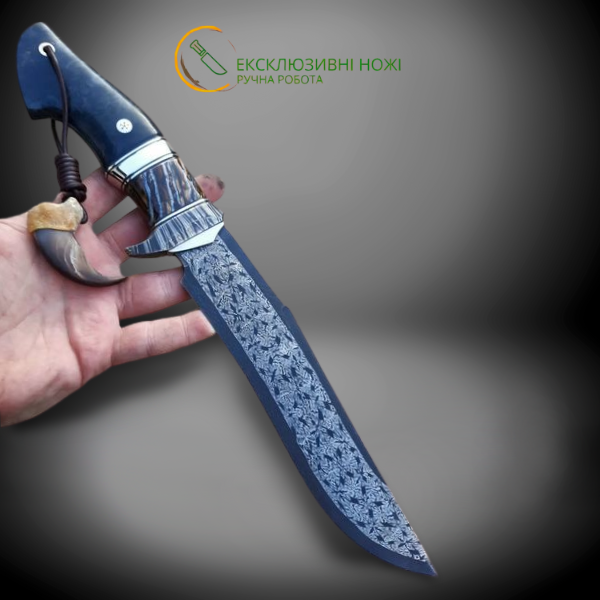
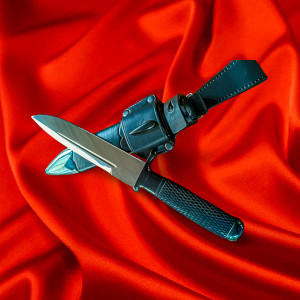
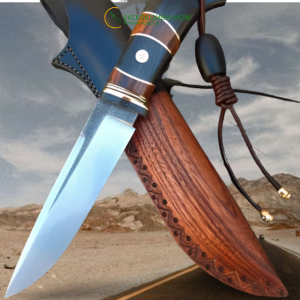
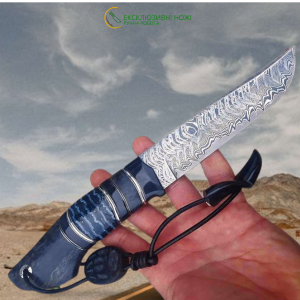
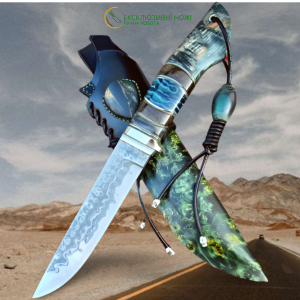
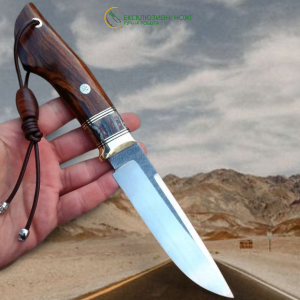
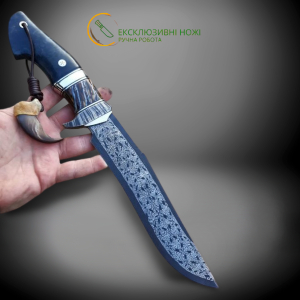
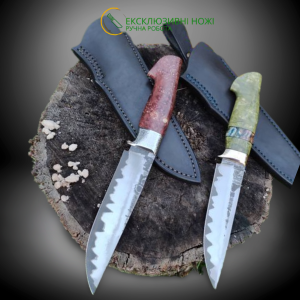
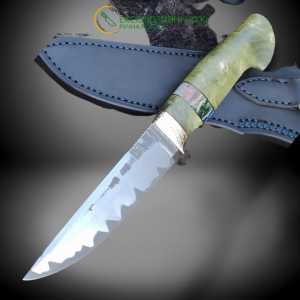
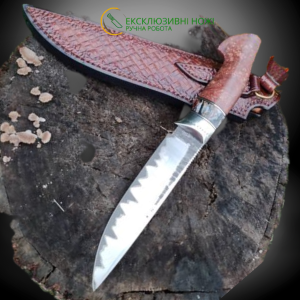
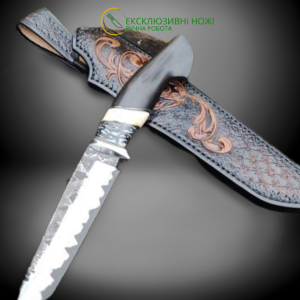
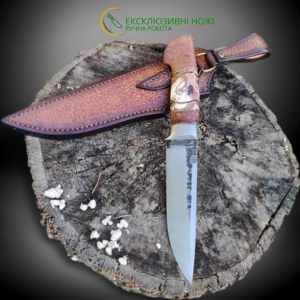
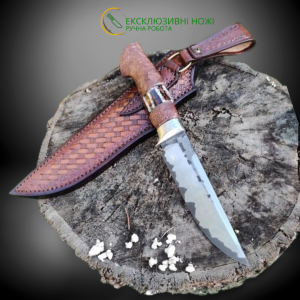
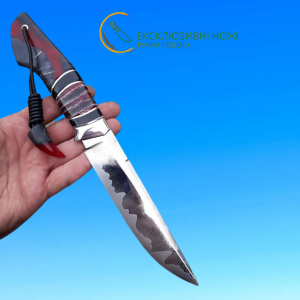
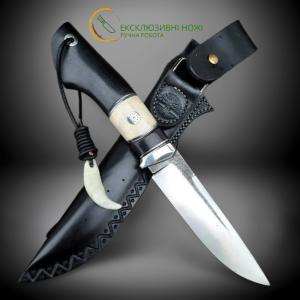
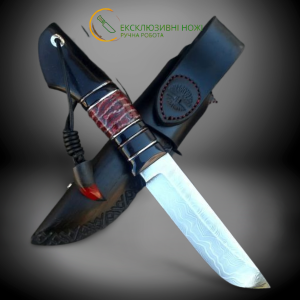
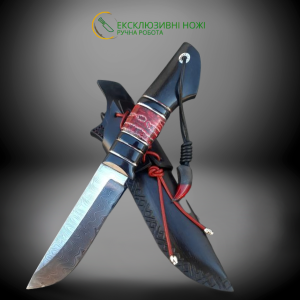
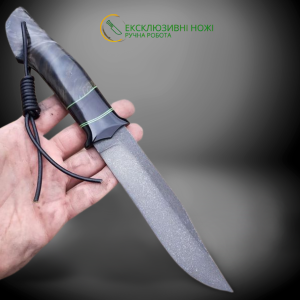
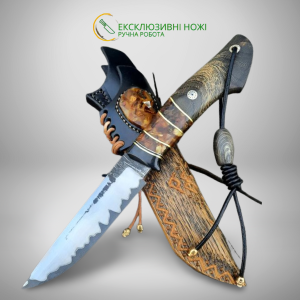
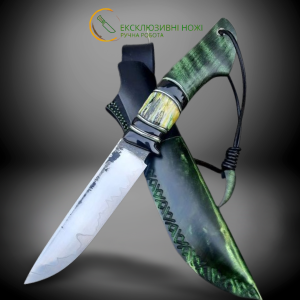
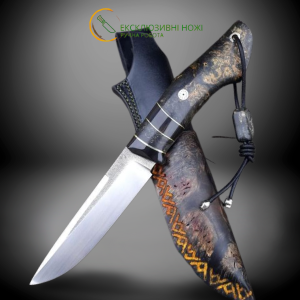
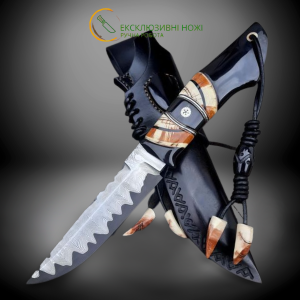
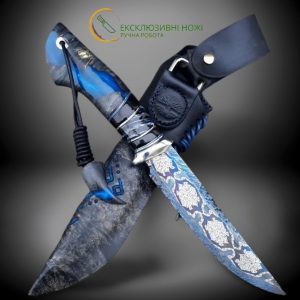
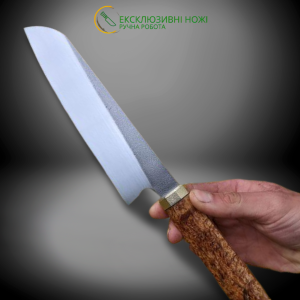
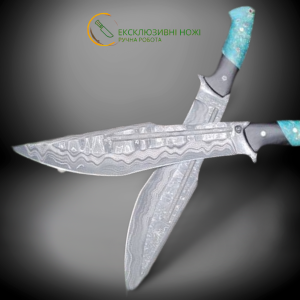
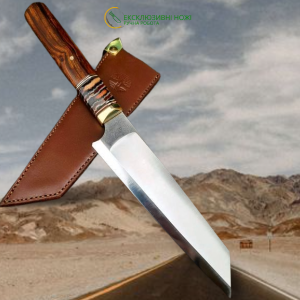
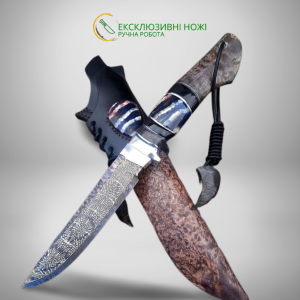

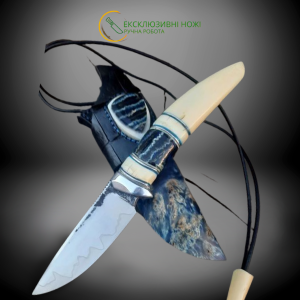
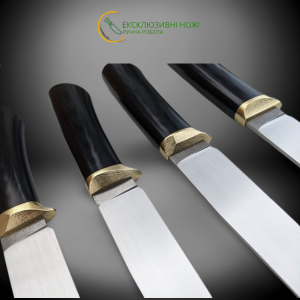
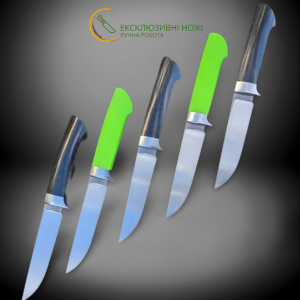
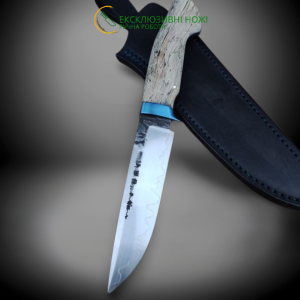
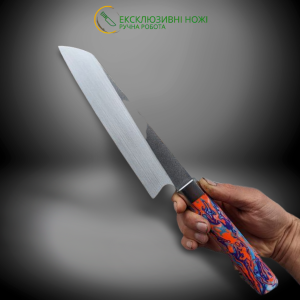

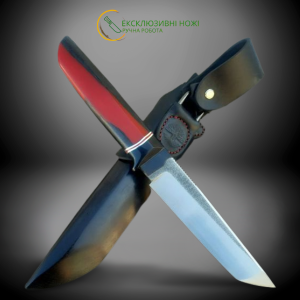
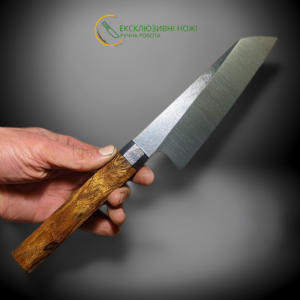
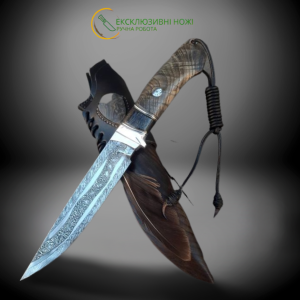

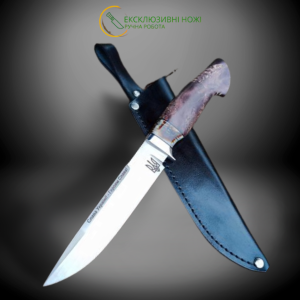

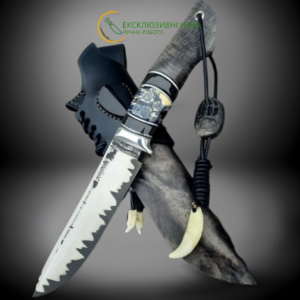
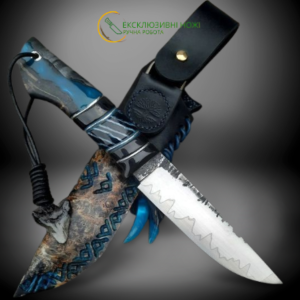

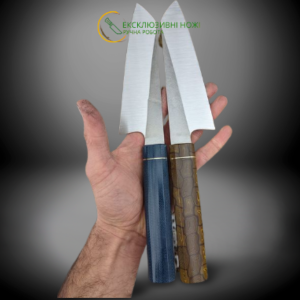

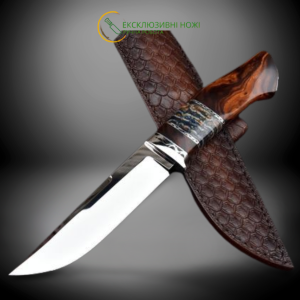
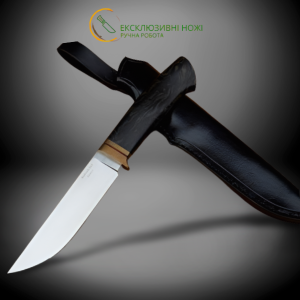
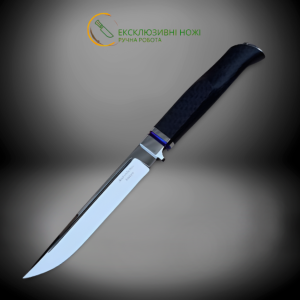
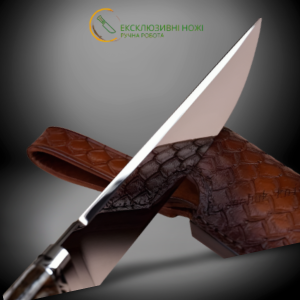
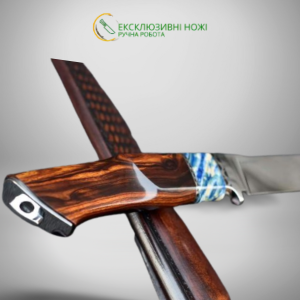
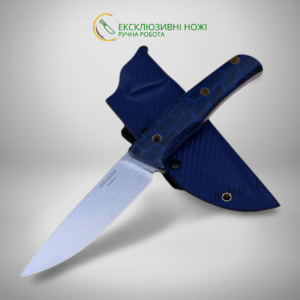
/EXELSIOR S90V ніж ручної роботи майстра студії Androshchuk Knives, купити замовити в Україні-300x300.png)
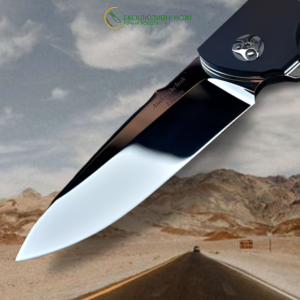
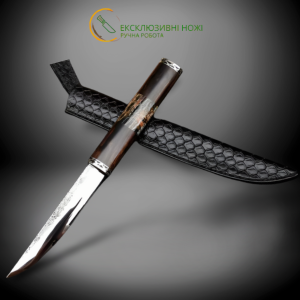
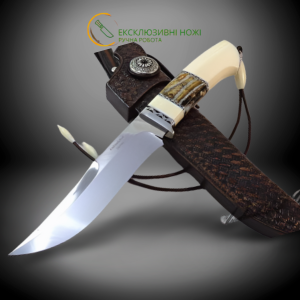
/JUNIOR BEAR (ЮНИЙ ВЕДМІД) ніж ручної роботи майстра студії ANDROSHCHUK KNIVES, купити замовити в Україні_зас-300x300.png)
-300x300.png)





























14-300x300.png)









17-300x300.jpg)
/НЕВИДИМИЙ II (чорний) ексклюзивний ніж ручної роботи майстра студії Fomenko Knifes, купити замовити в Україні16-300x300.jpg)




-300x300.jpg)


2 2-300x300.jpg)

/БОЦМАН (BOTSMAN) ексклюзивний ніж ніж ручної роботи майстра студії СЕРГІЯ ДРОЗДА, купити замовити в Україні (Сталь - CPM S110V) 2-300x300.jpg)
-300x300.png)
-300x300.png)
 -300x300.png)
 копія (1)-300x300.jpg)
 — середнє 2-300x300.jpg)
_заст-300x300.png)







 — середнє 2-300x300.jpg)














































, купити замовити в Україні_заст2 — середнє-300x300.jpg)
, купити замовити в Україні_заст-300x300.png)
, купити замовити в Україні_заст-300x300.png)
, купити замовити в Україні_заст-300x300.png)









, купити замовити в Україні-300x300.png)
, купити замовити в Україні_заст-300x300.png)
































































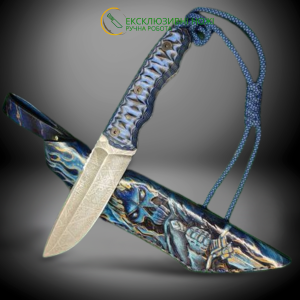
-300x300.png)



, купити замовити в Україні-300x300.png)
, купити замовити в Україні — середнє-300x300.png)


/АВІАТОР/АВІАТОР ексклюзивний колекційний ніж ручної роботи студії KUSTOM KNIVES купити замовити в Україні -300x300.png)
/ДЕЛЬФІН/ДЕЛЬФІН (Dolphin) ексклюзивний колекційний складний ніж ручної роботи студії KUSTOM KNIVES_застав2-300x300.png)
/МІНОС (Minos)/MINOS (МІНОС) ексклюзивний колекційний складний ніж ручної роботи студії KUSTOM KNIVES_заст-300x300.png)
/ВОЯДЖЕР (Voyager)/ВОЯДЖЕР (Voyager) ексклюзивний колекційний складний ніж ручної роботи студії KUSTOM KNIVES29_заст-300x300.png)
/IRONBELLY/IRONBELLY ексклюзивний колекційний складний ніж ручної роботи студії KUSTOM KNIVES — середнє 2-300x300.jpg)
/ОЛВАР (Olvar)/ОЛВАР (Olvar) ексклюзивний колекційний складний ніж ручної роботи студії KUSTOM KNIVES купити замовити в Україні_заст-300x300.png)
/НОВА ГОТИКА/НОВА ГОТИКА ексклюзивний колекційний ніж ручної роботи студії KUSTOM KNIVES купити замовити в Україні_заст-300x300.png)


/ЗОЛОТА ОСІНЬ/ЗОЛОТА ОСІНЬ ексклюзивний колекційний ніж ручної роботи студії KUSTOM KNIVES_заставка-300x300.png)
/ВЕСНА/ВЕСНА ексклюзивний колекційний ніж ручної роботи студії KUSTOM KNIVES купити замовити в Україні_заст-300x300.png)




























/GOLD NORD/GOLD NORD ексклюзивний колекційний ніж ручної роботи студії KUSTOM KNIVES купити замовити в Україні-300x300.png)

-300x300.png)

/PLUS+/PLUS ексклюзивний колекційний ніж ручної роботи студії KUSTOM KNIVES-300x300.png)









































/СЛІМ (Slim)/СЛІМ (Slim) скаладний ніж ручної роботи студії KUSTOM KNIVES, Сталь - Damasteel® RWL-34™ 61-62 HRC_заст — середнє-300x300.jpg)


















/ШЕВРОН (Chevron)/ШЕВРОН (Chevron) ексклюзивний складний ніж ручної роботи KUSTOM KNIVES7 — велике-300x300.png)





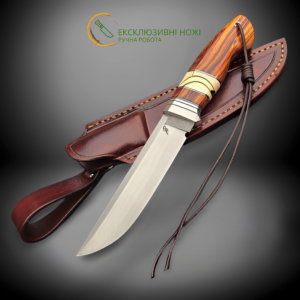

 ШЕФ/РЕД (RED) ШЕФ ніж ручної роботи майстра Fomenko Knifes1-300x300.png)








/ГАТОР (Gator)/ГАТОР (Gator) колекційний складний ніж ручної роботи студії LESBAR KNIVES_ЗСТ3-300x300.png)







-300x300.png)
-300x300.png)


















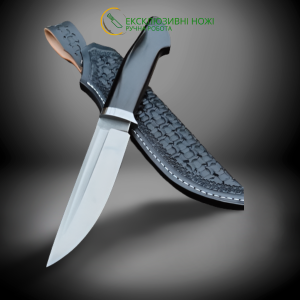
























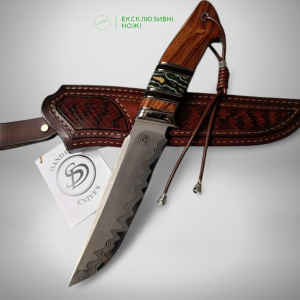
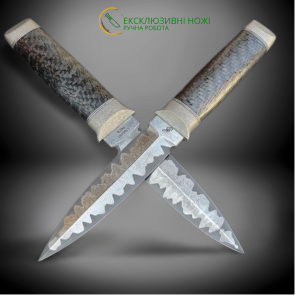
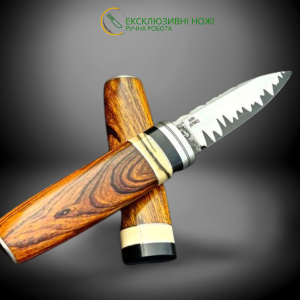
















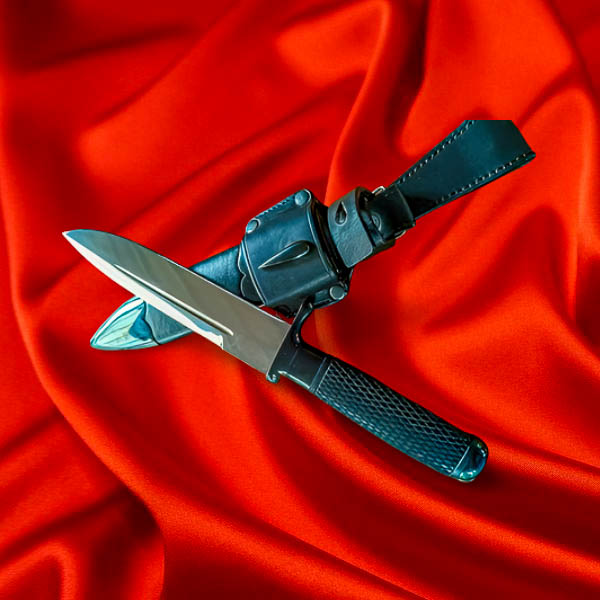


-600x600.png)
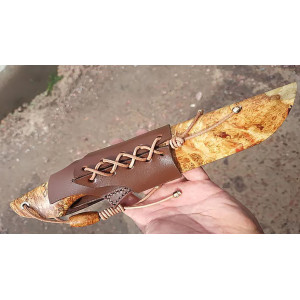
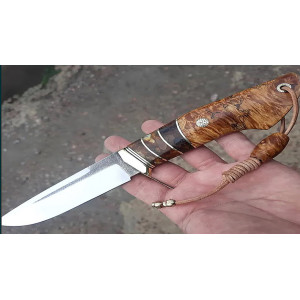






_заст-600x600.png)
9-300x300.jpg)
6-300x300.jpg)


























